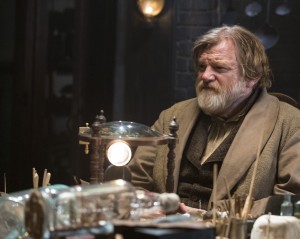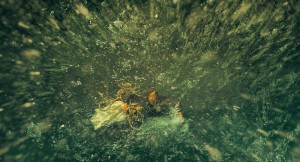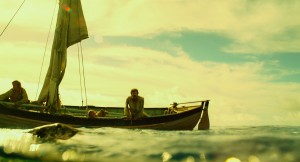
In case you didn’t already know, Herman Melville’s classic Moby-Dick was partially based on a real event. Obviously, he took some liberties, but ultimately delivered a story that many consider to be one of the great American novels. Rather than give this classic piece of literature a cinematic adaptation, the filmmakers have decided to shoot a 2000 non-fiction novel that details the inspiration for the story. And the result of this man vs. nature tale is quite choppy. In the Heart of the Sea has a few impressive moments, but ultimately gets lost at sea.
 The story opens with Melville (Ben Whishaw) hearing the tale from the traumatized survivor (Brendan Gleeson) of a doomed whaling expedition 30 years earlier. Cutting back and forth between time periods, the man relays the tale, focusing on the ship Captain George Pollard (Benjamin Walker) and his First Mate Owen Chase (Chris Hemsworth). Beyond the internal conflict between the inexperienced commander and the more knowledgeable crew leader, the group find themselves lost and fighting off an angry sperm whale, which seems to be purposefully hunting the sailors down.
The story opens with Melville (Ben Whishaw) hearing the tale from the traumatized survivor (Brendan Gleeson) of a doomed whaling expedition 30 years earlier. Cutting back and forth between time periods, the man relays the tale, focusing on the ship Captain George Pollard (Benjamin Walker) and his First Mate Owen Chase (Chris Hemsworth). Beyond the internal conflict between the inexperienced commander and the more knowledgeable crew leader, the group find themselves lost and fighting off an angry sperm whale, which seems to be purposefully hunting the sailors down.
While this would seem to pave the way for great drama, it all falls a little flat. There’s definitely conflict with a large sea creature, but not as much as viewers will expect. Sure, there are a handful of whale encounters, but the men quickly become stranded and lost in the Ocean and the story becomes more of a survival tale than a battle at sea. Of course, this would be fine if the characters were nuanced and detailed, but sadly, they are broadly written and never really believable. The heroic posturing employed by Chase early on doesn’t help matters, nor does Captain Pollard’s predictably stiff and snappy demeanor.
 The effects work is passable but never exceptional. There are numerous shots of the whale leaping out of the sea and flipping its tail at boats. The whole time, it’s never quite convincing. Even as storms rage, one never gets the feeling that the performers aren’t standing on a stage with a rain machine pouring down on them from above (with digital augmentation). The make-up is equally problematic; as events worsen and the seamen become ragged and sunburned, the effects never effectively sell the appearance.
The effects work is passable but never exceptional. There are numerous shots of the whale leaping out of the sea and flipping its tail at boats. The whole time, it’s never quite convincing. Even as storms rage, one never gets the feeling that the performers aren’t standing on a stage with a rain machine pouring down on them from above (with digital augmentation). The make-up is equally problematic; as events worsen and the seamen become ragged and sunburned, the effects never effectively sell the appearance.
 There are a few interesting wide angle shots with interesting focal points – often the camera is placed inches away from its subject (inches above a paper being scrawled on, attached to a mast being raised, next to the eye of the swimming whale). It’s an interesting trick and some of these shots stand out nicely. Unfortunately, most of the film is literally quite dark. There’s a consistent murkiness hanging over the proceedings, particularly during the numerous night sequences. Frankly, it’s difficult at times to even see the performer’s eyes. This distances the viewer even more.
There are a few interesting wide angle shots with interesting focal points – often the camera is placed inches away from its subject (inches above a paper being scrawled on, attached to a mast being raised, next to the eye of the swimming whale). It’s an interesting trick and some of these shots stand out nicely. Unfortunately, most of the film is literally quite dark. There’s a consistent murkiness hanging over the proceedings, particularly during the numerous night sequences. Frankly, it’s difficult at times to even see the performer’s eyes. This distances the viewer even more.
Pacing also suffers after the final encounter with the sperm whale. Our narrator doesn’t only relate how he was discovered, but also continues the story on land in Nantucket and through a court martial, not to mention a personal catharsis in the present day. It’s a bit of a slog and takes too long to wrap the story up.
There are some interesting individual scenes present, but in the end the characters and effects are never well-realized enough to maintain consistent suspension of disbelief. In the Heart of the Sea certainly aspires to epic status, but springs leaks early on and never really gets out of port.


